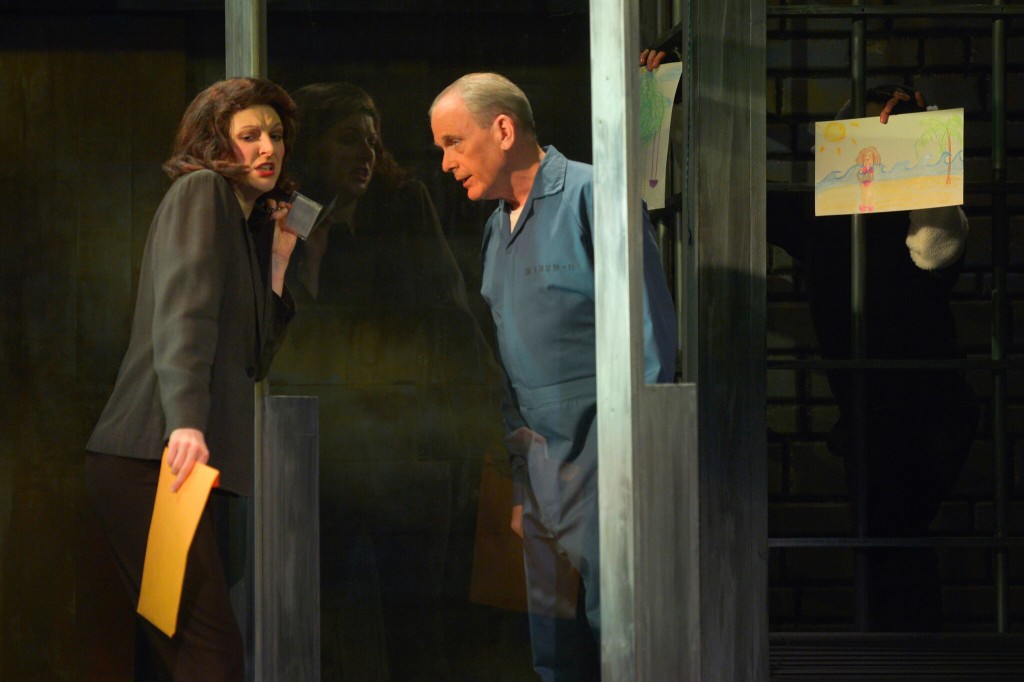
Last Friday, February 3, SILENCE! The Musical opened in the Victoria Theatre in San Francisco. The grungy space, complete with newspaper-inspired programs proclaiming the horror of Hannibal the Cannibal, seemed the perfect setting for a raunchy musical parody of the classic film The Silence of the Lambs. SILENCE! is a catchy walk down cinematic memory lane with hilarious comedic additions. Yet its camp is often too polished to feel campy, and the jokes lack the punch of wit that a parody of this classic film deserves.
The Silence of the Lambs is a 1991 thriller/horror film based on the Thomas Harris book of the same name. The tale follows bright-eyed FBI trainee Agent Clarice Starling, a young rural woman who worked her way up into a cutthroat cohort of mostly-male Baltimore officers. She begins the story low on the FBI ladder, desperate to prove herself by catching criminals. She is tasked with extracting information from the psychiatrist-slash-cannibal Hannibal Lecter on a time-sensitive serial killer case. The story revolves around the dance between the race to catch the killer and Lecter’s quest to sink his claws into Clarice’s mind.
SILENCE! opens with a re-visualization of the FBI training obstacle course scene from the start of the film, except with much more stumbling. Starling is surrounded by a chorus of singing lambs emerging in harmony, introducing the nightmarish tale-to-come in a haunting opening ballad. This sets the tone for the show: absurd, macabre, sometimes overdone (unlike Lecter’s cooking!), and filled with off-color misfits laid upon a solid foundation of up-and-coming musical composition.
 The set benefits from simplicity and flexibility. The stage effortlessly transforms from FBI headquarters to the eerie psychiatric hospital to the sites of Clarice’s childhood memories. The lines of these rolling structures are reminiscent of Lecter’s iconic cell from the film. These structures occasionally turn into never-ending labyrinths for the characters to dance in and chase each other through.
The set benefits from simplicity and flexibility. The stage effortlessly transforms from FBI headquarters to the eerie psychiatric hospital to the sites of Clarice’s childhood memories. The lines of these rolling structures are reminiscent of Lecter’s iconic cell from the film. These structures occasionally turn into never-ending labyrinths for the characters to dance in and chase each other through.
The richest fare of the show is its skilled, small cast. Anne Norland, as Clarice Starling, delivers a hysterical spoof of Jodie Foster with her outrageous lisp and unbridled naïve enthusiasm. She evokes a mix of empathy and schadenfreude as she gets repeatedly knocked down by sexual harassment from men in the workplace, silly-string semen from psychiatric patients, and Lecter’s manipulations—and then bounces right back up with her determined case-cracking numbers. Lecter (Scott Hayes) captures Anthony Hopkins’ unsettling controlled stillness, which exudes power despite the large space he plays to. His vibrato tenor nods to Hopkins’ distinct vocal choices, setting Lecter apart from the other characters by imbuing him with a disconcertingly proper air. The two leads enjoy sparks of chemistry amidst the comedy. During numbers like “Quid Pro Quo”, they deftly evoke the twisted seduction of their cat-and-mouse game through puppet-inspired choreography.
At-large serial killer Buffalo Bill (Brian Watson) escalates the camp in scenes when he’s distracted from his screaming victim by his sexual attraction to his own reflection. Clarice’s dead father hovers over her flashbacks with a country-song accent and a lisp only a little less dramatic than his daughter’s. Angel Adedokun steals the performance in a jazzy showstopper as minor FBI agent Ardelia Mapp.

Dr. Chilton’s performance was the only one that paled. The book, film, and now musical character is written as a schmuck, but it was unclear whether his hammy chair-choreography appeared forced for that reason, or because the actor wasn’t pulling it off. However, his fast-paced introduction to Lecter’s cell (peppered with overt flirtation with Clarice) is well-delivered and funny, with lyrics like, “So listen up, there’s just a few procedure rules to follow: if you get too close, he’ll grab your face and bite and chew and swallow!” declared with exuberant commitment.
Unfortunately, the writers (Jon Kaplan, Al Kaplan, and Hunter Bell) missed repeated opportunities for nuanced jokes. They frequently went straight for tasteless and outdated silliness. The show belabors obvious subtext into cringe-worthy pauses, laughs needlessly at stereotypes, and writes queerness itself in as a running joke. The third (and most unprintable) song riffs off of an unsettling line from inmate Multiple Miggs. This number introduces Lecter’s motivation in lyrics too early to be believable in-character and too misogynistic to sell their crassness. At one point, Clarice precedes over a victim’s autopsy with a whole string of “she’s so fat” jokes. For a parody of a film full of weird ideas ripe for joking, the picking of low hanging fruit was disappointing.
Nonetheless, SILENCE! makes use of several memorable details from its source material. It grabs idiosyncrasies taken seriously in the original and twists them into caricatures as only a parody should. The show is a treat not only for appreciators of over-the-top lewd humor, but for fans of the film who will grin each time they hear a familiar reference. While SILENCE! is no five-course meal of brains and liver, it serves a good time—and there’s chianti on tap at the theatre.
